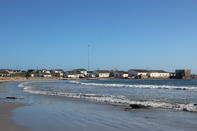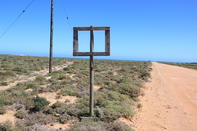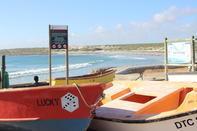Town History
Due to the opening of the copper mines in Namaqualand and their transport route to the sea, Hondeklip Bay had developed from a single trading store, owned by a Mr. Grace, into a ramshackle village with four trading stores and dozens of wooden shacks and a jetty. It was, by all accounts, a horrible place.

There was no inn, tavern or canteen in the settlement, and drinking water had to be shipped in from Cape Town. The only other liquid available was brandy, which was sold in 16-gallon casks. This led to widespread drunkenness and regular outbursts of violence among the copper riders. There was also no jail and the lone peace officer certainly had his hands full dispensing rough justice.
The anchorage at Hondeklip Bay was similarly problematic. It was exposed to the strong winds and rough seas, and there was a shortage of moorings in the inner harbour. Nevertheless, this was now the main transport hub in the region and the Cape Copper Company set about constructing houses, storerooms and other utilitarian buildings. In 1862, Hondeklip was made a magisterial district and a customs officer was appointed. Within 10 years, exports from the port amounted to 800 000 pounds, with imports of 450 000 pounds, which consisted mainly of supplies destined for the mines at Springbok.
But the town was still a dump. A contemporary visitor described it thus: ‘The wood, of the houses, is covered with tar, which prevents decay, but does not improve its appearance. The ground on which it stands, and for miles around, is loose sand, which is blown about by the wind. The frequent sea fogs are very damp and unpleasant… It would be difficult to find a more disagreeable place’.
A Tramline

By 1865, nothing had been done about either of the roads to the coast, and the situation was getting worse. The Divisional Council of Namaqualand, which was established in 1861, complained that it spent most of its revenue keeping the Hondeklip Bay road in repair, even though it was still terrible. The farmers living in the Hardeveld and at Kamiesberg were also unhappy that their rates were going into the road, even though it was of little use to them. So, yet another Select Committee was established ‘on Namaqualand Roads and Tramway’. This time, the government brought a roads inspector, Patrick Fletcher, to decide on whether the road should be constructed to Hondeklip Bay or Port Nolloth. Meanwhile, the Cape Copper Company got in their own engineer, Thomas Hall.
Surprisingly, Hall advised that Springbok to Port Nolloth road was preferable and proposed building a tramline from Port Nolloth across the Sandveld to the farm Muishondfontein. Fletcher, however, suggested improvements to the Hondeklip Bay road, even though it would be expensive to build and maintain. This latter recommendation was apparently based on the needs of the copper riders who were already based in the Hondeklip area. It was subsequently decided that a new road to Hondeklip Bay should be built and permission was granted for the Cape Copper Company to build a tramway from Hondeklip Bay across the Sandveld to the farm Riethuis, although this tramway never materialised.
Under Construction

And so, in 1867, construction on the long-awaited road to Hondeklip Bay was commenced, under the supervision of Patrick Fletcher. It was called the Messelpad (Mason’s Road) because of all the high dry-stone retaining walls that had to be constructed to push the road over the mountains. Convicts were used to supply the labour, and accommodation and transport for these road gangs were supplied by the Cape Copper Company. Even so, by the time the road was completed in 1871, it had cost a total of £10 000. This road still exists today and offers the modern motorist a wonderful scenic drive. The ruins of the old convict’s compound can also be seen.
Unfortunately, the Messelpad came too late for Hondeklip Bay. In the late 1860s, the Cape Copper Company revamped its transport operations by putting the riders under contract. From then on, only 30 or 40 men were allowed to transport the company’s ore, and they were paid at Okiep and supplied from company stores, thus depriving the Hondeklip traders of their most important customers.
A Shadow of its Former Self

Then, in 1869, the decision was made to develop Port Nolloth as the major seaport in the region and the Cape Copper Company was granted permission to build a railway line across the Sandveld from the port to Muishondfontein. Thomas Hall was recalled to begin construction and the first 46 miles of line was opened in 1870. The new route from O’okiep over the Anenous Pass to the railhead at Muishond proved very popular. Ore exports almost doubled within the year and copper riding over the nearly-completed Messelpad decreased dramatically.
Within a few years, Hondeklip Bay was a shadow of its former, boisterous self. The copper riders had departed and all but one of the shopkeepers left town. By 1877, Hondeklip Bay had ceased to be a separate magisterial district and was no longer regarded as a port. The town barely survived and only became viable again with the growth of the fishing industry. A cannery was built in 1925, but this closed in the latter part of the twentieth century.